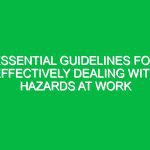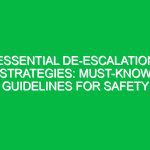“`html
Essential Tips for Effectively Dealing with Stress from Home
Introduction
Good morning team,
Today, we are going to discuss a topic that has become increasingly relevant in our modern work environment: effectively dealing with stress from home. As many of us continue to work remotely, the lines between our professional and personal lives can blur, leading to heightened stress levels. Understanding how to manage this stress is not just important for our mental well-being, but it is also crucial for maintaining a safe and productive workplace.
Let’s explore why this topic matters and how we can implement practical strategies to manage stress effectively.
Understanding Stress from Home
Stress from home refers to the emotional and physical strain that arises from challenges faced while working remotely. This can stem from various factors such as isolation, work-life balance issues, and the lack of a structured work environment. Understanding the impact of stress is vital, as it can affect not only our personal health but also our productivity and the overall Safety of our workplace.
Common misconceptions include the belief that working from home eliminates stress. In reality, many employees experience increased stress due to the absence of clear boundaries between home and work, leading to longer hours and a sense of being ‘always on’.
Key Hazards, Risks, and Safety Considerations
Identifying the Hazards associated with stress from home is the first step in addressing them. Here are some specific risks:
- Burnout: Continuous stress without relief can lead to physical and emotional exhaustion, reducing productivity.
- Isolation: Working alone can lead to feelings of loneliness and a lack of support, which can exacerbate stress.
- Poor Ergonomics: Uncomfortable workspaces can contribute to physical ailments, adding to stress levels.
If these risks are ignored, the consequences can be severe, including mental health issues, decreased job performance, and an unsafe work environment.
Best Practices, Procedures, & Actionable Advice
Now that we have identified the risks, let’s delve into some Best Practices for managing stress effectively:
- Create a Dedicated Workspace: Set up a specific area in your home that is designated for work. This helps to establish boundaries and minimizes distractions.
- Establish a Routine: Develop a daily schedule that mirrors your pre-remote work routine. Include regular breaks and stick to a consistent start and finish time.
- Practice Mindfulness: Incorporate mindfulness techniques, such as meditation or deep breathing exercises, to help manage stress and improve focus.
- Stay Connected: Schedule regular check-ins with colleagues to foster a sense of community. Use video calls or chat applications to maintain communication.
- Prioritize Self-Care: Engage in activities that promote physical and mental well-being, such as exercise, hobbies, or spending time with family.
For example, consider a case where an employee struggled with isolation while working from home. By setting up regular virtual coffee breaks with colleagues, they were able to combat feelings of loneliness and build camaraderie, significantly reducing their stress levels.
Regulations, Standards, and Compliance
While working from home, it is essential to adhere to relevant safety Regulations and Standards, such as those outlined by OSHA. Compliance with these standards ensures that employees maintain a safe and healthy work environment, even when working remotely.
Ignoring these regulations can lead to increased risk of injury or illness, which can affect not only individual employees but also the entire organization.
Employee Engagement & Discussion
Now, let’s open up the floor for discussion. Here are some questions to consider:
- What specific challenges related to stress have you faced while working from home?
- How do you currently manage stress, and what strategies have been the most effective for you?
- Are there additional resources or support systems that would help you cope with stress better?
Your insights are invaluable, and sharing experiences can help us all find better ways to manage stress together.
Conclusion & Key Takeaways
To wrap up, managing stress from home is essential for our well-being and Workplace Safety. Remember the following key points:
- Create a dedicated workspace to establish boundaries.
- Maintain a regular routine to enhance productivity.
- Engage in mindfulness and self-care practices.
- Stay connected with colleagues to reduce feelings of isolation.
- Adhere to safety regulations and standards to protect yourself and others.
By implementing these strategies, we can create a healthier work environment that prioritizes our mental and physical well-being. Thank you all for your attention and commitment to safety. Let’s make it a priority to support each other in managing stress effectively!
“`


